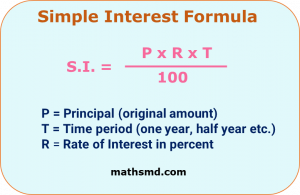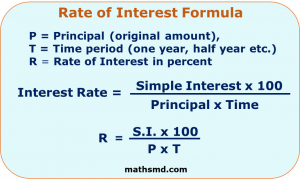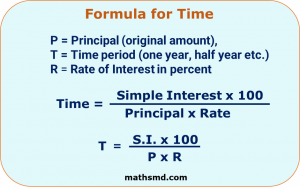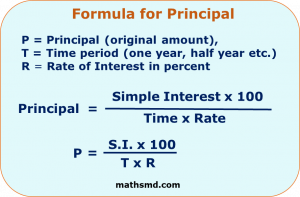Simple Interest – Definition – Formula – Examples
Simple Interest: Definition, Examples and Formulas
What is interest?
First lets understand what is Interest. When we borrow money from a bank, we must pay a fee in addition to the amount borrowed. The extra money we pay is known as the interest.
Interest is an additional amount of money that is paid by the borrower to an investor or a lender.
This money would be used by the borrower, and returned after some time. For keeping this money for some time the borrower has to pay some extra money to lender. The extra money paid by borrower is known as interest.
Interest is a fee, we pay on a loan or income we earn on deposits.
What is simple interest?
Simple interest is an easy and quick method to calculate the interest on the money, in this method interest always charged on a sum(original principal amount) at a particular rate and specified period of time.
Simple interest is the method to calculate the amount we will pay or earn for a loan or investment.
Let us understand, what is the meaning of a loan. A loan is an amount that a person borrows from a bank or a financial authority to fulfill their needs.
For example car loan, home loan, personal loan, education loan. A loan amount is required to be returned by the person to the lender on time with an extra amount, which is usually the interest we pay on the loan.
Simple Interest Definition
Simple interest is an easy and quick method of calculating the amount of interest, simple interest always charged to the original principal amount, with a same rate of interest and specified period of time.
How to calculate Simple Interest
The simple interest of an amount is calculated by multiplying the principle amount by the interest rate and the time period. This time period usually would be in years.
Generally interest is given in percent for a period of one year. It is written as 5% per year or per annum or in short as 5% p.a. (per annum). 5% p.a. means every $100 borrowed, $5 is the interest we have to pay for one year.
Simple interest is used in many sectors such as finance, automobile, banking etc.
Let’s take an example and understand how this works.
John wants to buy a new scooter, merry asked to him whether he had the money to buy it. John said he will take a loan from a bank.
The money borrow by john from bank is known as sum borrowed or principal.
When we borrow money from a bank, we must pay a fee in addition to the amount borrowed.
Amount: When a person takes a loan from a bank, he/she has to return the principal borrowed plus the interest amount and this total returned is known as Amount.
Amount is denoted by A.
We can find the amount, we have to pay at the end of the year by adding the sum borrowed and interest. That is,

Rate: Rate of interest at which the principle amount is given to someone for a certain time is known as rate.
The rate of interest is denoted by R.
Time: Time is the duration for which the principal amount is given to someone.
Time is denoted by T.
Interest: Interest is the extra money that the borrower paid in addition to the principal.
Interest is denoted by I.

A – is the Amount due at the end of the time period
Amount = Principal + Interest

Simple Interest Formula in maths
Simple Interest Formula is given as:
Simple Interest (SI) = [{(P x R x T)}/100]
SI – is the simple interest

R – Rate of Interest in percent

T – Time period (one year, half year etc.)

P – Principal amount(original amount)

We can also calculate the
(i) Principal amount P = [{100 x (Simple Interest)}/(R x T)]
(ii) We can calculate the Rate R = [{100 x (Simple Interest)}/P x T}]
(iii) We can calculate the Time T = [{100 x (Simple Interest)}/P x R}]

Amount A = Principal (P) + Simple Interest
A = P + SI
Adding the sum borrowed and interest we can find the amount pay at the end of the year.
Generally interest is given in percent for a period of one year. It is written as 10% per year or per annum or 10% p.a.(per annum).
Let us see the formula to calculate the interest for months and days.
The formula can be written as
Simple interest for k months = (P x k x R)/(12 x 100), Where k = Number of months
Simple interest for d days = (P x d x R)/(365 x 100), Where d = Number of days(non-leap year)
Simple Interest Problems
Let’s see some examples of the simple interest using simple interest formula in maths.
Example 1: What is the simple interest of $ 7000 at the rate of 12% per year for 5 years.
Solution: Here, Principal amount P = $7000
Rate of interest per year = R = 12%
Time for which it is borrowed = T = 5 years
Simple Interest (SI) = [{(P x R x T)}/100]
put the values in the formula
Simple Interest (SI) = (7000 x 12 x 5)/100
Simple Interest (SI) = $4200
Example 2: What is the simple interest of $ 6000 at the rate of 5% per year for 2 years.
Solution: Here, Principal amount P = $6000
Rate of interest per year = R = 5%
Time for which it is borrowed = T = 2 years
Simple Interest (SI) = [{(P x R x T)}/100]
put the values in the formula
Simple Interest (SI) = (6000 x 5 x 2)/100
Simple Interest (SI) = $600
Example 3: John takes a loan of $ 10000 from a bank for a period of 1 year. The rate of interest is 10% per annum. What is the simple interest and the amount he has to pay at the end of a year.
$ 10000 at the rate of interest 10% per year for 2 years.
Solution: Here, Principal amount P = $6000
Rate of interest per year = R = 10%
Time for which it is borrowed = T = 1 year
Simple Interest for a year (SI) = [{(P x R x T)}/100]
put the values in the formula
Simple Interest (SI) = (10000 x 10 x 1)/100
Simple Interest (SI) = $1000
Amount that has to pay to the bank at the end of the year
= Principal + Interest
= $ 10000 + $ 1000
= $ 11000